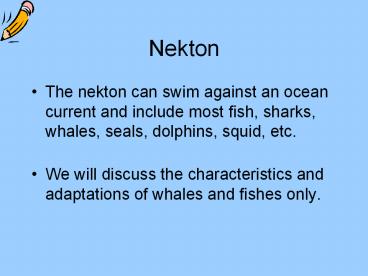Nekton - PowerPoint PPT Presentation
1 / 21
Title:
Nekton
Description:
Nekton The nekton can swim against an ocean current and include most fish, sharks, whales, seals, dolphins, squid, etc. We will discuss the characteristics and ... – PowerPoint PPT presentation
Number of Views:144
Avg rating:3.0/5.0
Title: Nekton
1
Nekton
- The nekton can swim against an ocean current and
include most fish, sharks, whales, seals,
dolphins, squid, etc. - We will discuss the characteristics and
adaptations of whales and fishes only.
2
Whales
- Whales are marine mammals that breathe air, are
warm-blooded, and feed milk to their young, just
like humans - There are two main groups of whales
- those with teeth
- those with baleen
3
Toothed Whales
- These include dolphins, porpoises, killer whales,
belugas, and sperm whales - Sperm whales are the largest toothed whale. They
can dive to great depths (1000m) and stay under
for an hour. They feed mostly on squid.
4
Baleen Whales
- Include all the largest species of whales - blue,
fin, sei, humpback, minke, right - They have 300-500 plates of baleen that hang from
each side of the upper jaw instead of teeth,
which they use to sieve krill out of the water - An average humpback will eat 1-1.5 tons of krill
per day
5
Interesting Whale Facts
- Blue whales are the loudest animals on Earth!
Their call reaches levels up to 188 dB. This
whistle can be heard hundreds or perhaps even
thousands of miles away. The blue whale is louder
than a jet, which reaches only 140 decibels!
6
Interesting Whale Facts
- Orcas are the fastest whales, reaching speeds of
up to 48 km/hr - Humpback whales sing the most complex songs
only males sing - Narwhals have the longest tooth 7-10 feet long
7
Adaptations of Whales
- Streamlined bodies
- Powerful tail flukes
- Thick blubber layer to keep warm
- Twice as many red blood cells as other land
mammals - During dives - heart rate slows to conserve O2
- Water-tight seals on blowholes
8
Video Mammals of the Sea
9
Fish
- Fish are cold-blooded animals and possess gills
for breathing and fins for swimming - They live near the surface to the ocean depths,
in warm water and icy water - There are two main groups of fish
- Cartilage fish (sharks, skates and rays)
- Bony fish (tuna, cod, halibut, etc)
10
Cartilage Fish
- Cartilage fish lack bones and have a skeleton
made out of cartilage (the stuff that is in your
nose) - Cartilage fish are negatively buoyant will sink
if they stop swimming - Skates and rays have flattened bodies and
wing-like fins
11
Sharks
- Most sharks have several rows of teeth, but some
are planktonic filter feeders (whale shark,
basking shark) - Predatory sharks have a keen sense of smell and
are able to detect vibrations in the water to
locate prey
12
Sharks in Our Waters
Basking
Great White
Porbeagle
13
Other Cartilage Fish
14
Bony Fish
- Bony fish display the greatest diversity of all
the vertebrates - Possess air-filled swim bladders to aid in
buoyancy - 86 million tons of fish are taken each year for
food
15
Bony Fish, contd
- Sight and hearing are well-developed to obtain
prey and avoid predators - Bony Fish also have a lateral line system which
is a series of pores along the side of the fish.
It is used to detect vibrations in the water
16
Some Unusual Bony Fish
17
Adaptations of Fish
- Hydrodynamic torpedo shaped bodies
- Well-developed muscles for swimming
- Fins specialized for the particular fishs mode
of life - Countershading (dark on the dorsal side light on
the ventral) aids in camouflage from prey and
predators
18
Label the Fish Parts
19
Types of Caudal Fins
Slow
Fast
20
(No Transcript)
21
Video Fish































